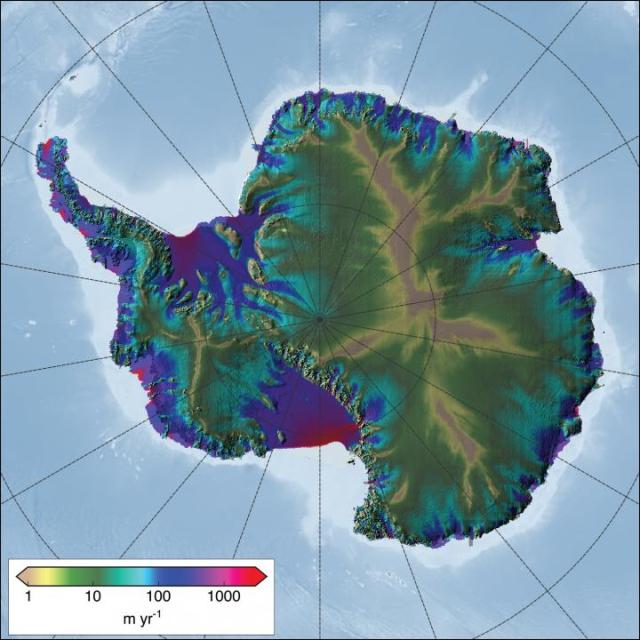Sep 26 2015
To see how burning up the Earth's available fossil fuels might affect the Antarctic ice sheet, scientists turned to a computer program developed at the University of Alaska Fairbanks Geophysical Institute. The ice would disappear, they found, and that conclusion is making headlines across the world.
 This is an example of how the Parallel Ice Sheet Model simulates the movement of ice in the Antarctic ice sheet by using different colors. Andy Aschwanden used high-performance computers from the Geophysical Institute's Research Computing Systems to create the model.
This is an example of how the Parallel Ice Sheet Model simulates the movement of ice in the Antarctic ice sheet by using different colors. Andy Aschwanden used high-performance computers from the Geophysical Institute's Research Computing Systems to create the model.
UAF's Parallel Ice Sheet Model "was the perfect tool to find out whether human emissions are sufficient to render Earth ice free -- and unfortunately it turns out that they are," said Anders Levermann, a researcher at the Potsdam Institute for Climate Impact Research in Germany. Levermann is an author of a paper recently published in the journal Science Advances.
He and the paper's other authors figured out that burning all available fossil fuels would release about 10,000 gigatons of carbon into the atmosphere, which could possibly raise the average temperature of the planet by 20 degrees Fahrenheit. One gigaton is one billion tons. More carbon dioxide in the atmosphere raises temperatures because the greenhouse gas traps infrared radiation from sunlight striking the Earth.
The computer program shows that the increased temperatures would melt the Antarctic ice sheet, which is bigger than the United States, has an average thickness of 6,200 feet and contains more than 50 percent of the world's fresh water. More than half the melting could occur during the first 1,000 years, although the entire study spans 10,000 years. PISM also shows that the melting would push sea levels up by more than 160 feet. Coastlines would retreat, forcing people in places like New York City, London and Paris to move inland.
"The future evolution of the global sea level is mainly determined by the melting of the big ice sheets on Greenland and Antarctica," Levermann said. "If we want to properly protect our cities, we need to know how these ice sheets evolve. Models like PISM are the only chance we have to understand future sea-level rise."
Andy Aschwanden, a UAF glaciologist who helped develop PISM, said he uses the computer program to study how climate change could affect Greenland's ice sheet. He said that more than 50 studies have used PISM, including a soon-to-be-published paper that investigates the future of Alaska's Juneau Icefield.
"Models are testbeds for all sorts of questions, and PISM is what we call a numerical model." said Aschwanden. "We take our best understanding of the physical processes of the real world, in this case ice sheets, and frame that in the language of mathematics. Then we teach the computer how to come up with solutions to 'what if' questions about the processes that this model represents. We did a lot of work under the hood to make this model work."
Ed Bueler, a UAF associate professor of mathematics, and GI computer programmer Constantine Khroulev, did much of that work. They built the engine of this model from new mathematical equations. Bueler said PISM is designed to solve what-if scenarios for different-sized ice sheets and glaciers over a time period that extends 100,000 years into the future and the past. It considers such factors as ice thickness and temperature, the weight of the ice and how fast the ice flows as gravity slowly pulls it downhill "like pouring honey onto a pancake."
"The equations are a way to say precisely how the parts of an ice sheet work and how each of these pieces is connected to all the others," said Bueler. "Once you have the equations, you can make predictions."
Most programs that handle such a wide range of scenarios over a large time span rely on mathematics so complex that it may take computers years or decades just to answer one problem. Bueler said PISM is complex enough to be accurate but efficient enough to deliver answers in a timely manner to scientists.
PISM also uses the GI's high-performance computers to get more accurate answers to the wide variety of scenarios. These computers can outperform an average personal computer in processing calculations.
The PISM team posts the computer program and its updates on the Internet so that scientists can use it freely and provide feedback on the program. Levermann learned about the program after one of his graduate students found it on the Internet and showed it to him in 2008.
"Half a year later, I was flying to Fairbanks to discuss the model with Ed," said Levermann. "That was my first Halloween party in the U.S. In the two following weeks, my two then-Ph.D.-students, Ricarda Winkelmann and Maria Martin, visited Ed, and he explained the model. That started a wonderful long-term collaboration."
Winkelmann went on to be the lead author on the recent paper published in Science Advances.
Source: http://www.uaf.edu/